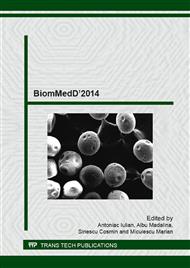p.197
p.205
p.210
p.216
p.222
p.228
p.233
p.238
p.243
A Medical Perspective Regarding the Use of Biomaterials for the Treatment of Hydrocephalus in Children
Abstract:
Hydrocephalus is a medical condition consisting of an abnormal accumulation of cerebrospinal fluid in the ventricles of the brain. This may cause increased intracranial pressure, progressive enlargement of the head, followed by ischemia, convulsions, tunnel vision, and mental disability and even death. This affection usually appears due to the blockage of cerebrospinal fluid (CSF) flow in the ventricles or in the subarachnoid space surrounding the brain. In a person without hydrocephalus, CSF continuously circulates through and around the brain, its ventricles and the spinal cord and is continuously drained away into the circulatory system. Alternatively, the condition may result from an overproduction of the CSF, from a congenital malformation blocking normal drainage of the fluid, or from complications of head injuries or infections.In the treatment of hydrocephalus, the implementation of perfectly tolerable materials enables surgeons to carry out a progressive drainage of excess cerebrospinal fluid towards other cavities of the body. By today’s standards silicone based biomaterials are the sum of all progress in biomaterial science, immunology and pathology. Lack of an immune signature, chemical and biological stability, perfect adhesion resistance and many more ultrastructure-related features come as perfect proof for the impact material science has on medicine. Future biomaterials, coated with antibiotics or antibodies are now closer than ever to be implemented in medicine.
Info:
Periodical:
Pages:
222-227
Citation:
Online since:
March 2015
Authors:
Keywords:
Price:
Сopyright:
© 2015 Trans Tech Publications Ltd. All Rights Reserved
Share:
Citation:


